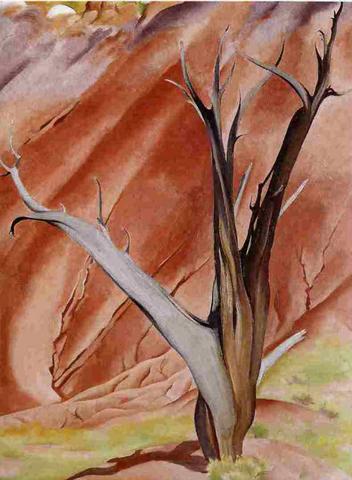The first of these artists, Georgia O'Keeffe, enjoys her widest acclaim for oil painting images of flowers and the American West. Though I was born in Atlanta, my parents insist that my first name, Georgia, was inspired by the artist. Her work has instilled in me a wonder for the minute details of the natural world and an appreciation for composition. In 1976, O'Keeffe wrote, "I have picked flowers where I found them, have picked up sea shells and rocks and pieces of wood where there were sea shells and rocks and pieces of wood that I liked. When I found the beautiful white bones on the desert I picked them up and took them home too. I have used these things to say what is to me the wideness and wonder of the world as I live in it.”
One may experience the works of O'Keeffe firsthand at the Georgia O'Keeffe Museum in Santa Fe, NM. Below, a quick excerpt from the museum website describes the current exhibit:
"O'Keeffiana: Art and Art Materials, offers a view of her artistic practice in a rich selection of artworks in various media – watercolor, charcoal, graphite, pastels, oil, and sculpture – along with a sampling of the pastels, watercolors, oil paints and brushes, she used. The exhibition will also include photographs of O’Keeffe at work and in the landscape that inspired her, and a selection of the stones and bones she collected and represented in paint and sculpture."
Click here to read a New York Times article on "O'Keeffiana: Art and Art Materials".
My next influence of not comes from one of the most prized possessions in my childhood household -- an authentic Eames bent plywood chair. From husband and wife design team, Charles and Ray Eames, I have learned important lessons about proportion, line, function and materiality.
To American art and design, the Eames' have contributed countless works including furniture, architecture, textiles, sculpture, video and printmaking. Currently, the Eames Office in Santa Monica, CA is displaying Eames exhibit "Powers of Ten: A Rough Sketch for a Proposed Exhibition on Scale".
Earlier this year, the Eames Office hosted a one-night exhibit celebrating the Eames' typographical achievements. An excerpt from the event invitation is below:
"Please join us as we introduce the illustrative beauty and cumulative functionality of Eames Century Modern with a three-dimensional tactile typographic experience at the Eames Office Gallery in Santa Monica. A cornucopia of free-standing dimensional letterforms and hand-printed installations celebrate the intricate curves and stunning stroke contrast that are the building blocks of this new font collection."
My personal introduction to the next artist, Keith Haring, came during middle school. The color, playfulness and deceiving simplicity of Haring's cartoon-inspired pop graphics immediately appealed to my pre-adolescent aesthetic. Haring rendered his art public and commercial like no other American artist. He tackled a wide range of subject matter including love, humanity, politics and sexuality. Alternately uplifting and dark, Haring's graphics express emotion in a way that is uniquely impactful and accessible. Haring has described his artistic motivation saying, "When I am sad, I color the world. . .I color a lot."
If you are ready to travel, a current exhibit of Haring's work, "Keith Haring: Pop Art Superstar" may be seen September 18 - November 14, 2010 at the Lotte Art Center in Busan, South Korea. A full schedule of Keith Haring exhibits may be found on the artist's official website.
Click here to for a Korea Times article on "Keith Haring: Pop Art Superstar".
Next on my list is a folk artist whose work I first encountered during college. Joseph Cornell was a self-trained artist and social recluse. He is considered to have been a pioneer in the art of sculptural assemblage and collage. The majority of Cornell's works begin with meticulously crafted shadow boxes on a relatively intimate scale. These boxes contain images and objects that, together, held deeply personal meanings to the artist. Often, Cornell designed the assemblages with moving parts or compartments meant to be discovered and manipulated by the viewer. In contrast to Haring's publicly proclaiming works, Cornell's boxes give viewers the sense that they are peering into a shadowy corner of the artist's private consciousness.
Most recently Cornell's work was exhibited at Spruth Magers London. From June to August, the museum featured the work of Cornell alongside contemporary artist, Karen Kilimnik. "Joseph Cornell Karen Kilimnik" featured eight of Cornell's signature boxes.
If you missed the exhibit in London, another great way to see Cornell's work is through an interactive site prepared by the Smithsonian Art Museum for a 2007 exhibit "Joseph Cornell: Navigating the Imagination".
Last on my list for today's blog entry is contemporary oil painter Cynthia Guild. Certainly less well known than the artistic giants discussed above, Guild's images have nonetheless significantly impacted the way that I view both my daily surroundings and the realm of fine art. I was first exposed to a collection of Guild's work titled "Traffic" a few years ago at a small art gallery in Wellfleet, MA. Harmon Gallery still exhibits Guild's work today. "Traffic" features a series of images of cars on highways at night. Having fallen in love with the naturally inspired paintings by Georgia O'Keefe at such a young age, I was startled by the intense connection I feel to Guild's contemporary, urban paintings.
Another series, "Freighters" is equally exquisite.























No comments:
Post a Comment